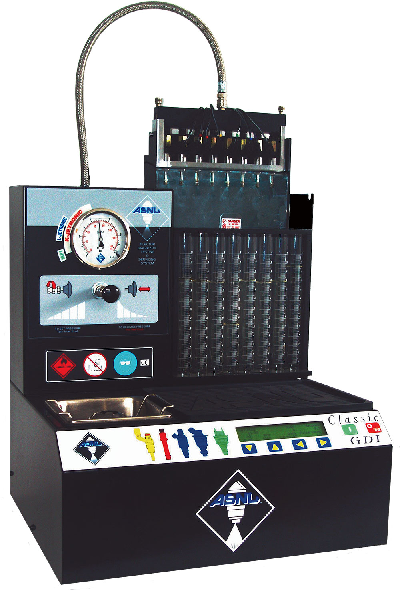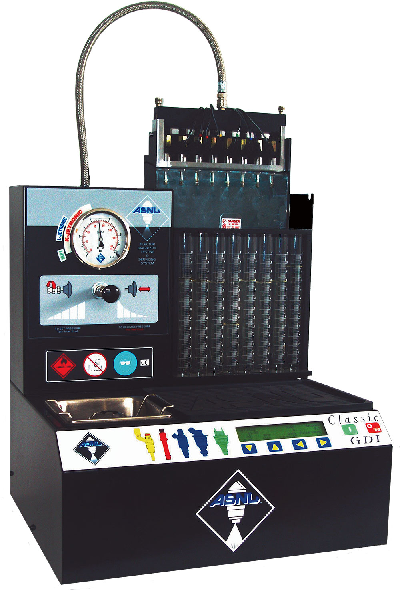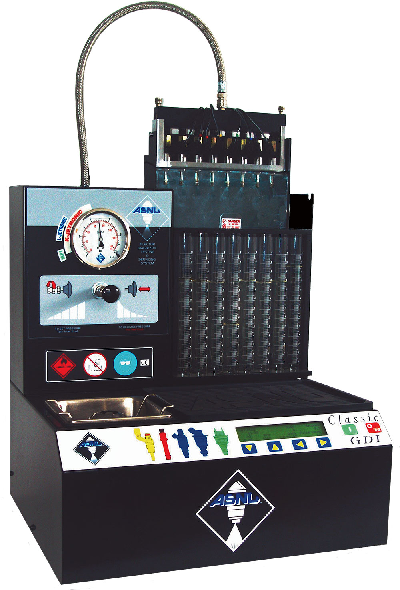Injector Cleaner
| Brochure | Video | Accesories |
Injector Cleaner And Tester
Classic GDI
PRODUCT DESCRIPTION
To enable a safe and easy examination of the injector’s performance, the ASNU system runs the injectors at a lower and safer operating fuel pressure of up to a maximum of 10 bar. On a vehicle fitted with a GDI system the fuel pressure will operate at a potentially dangerously high level for the inexperienced, reaching anywhere between 75 bar up to 200 bar on some systems
- Features
Backlit Viewing Window
Multi Language Selection
Digital Operational Display
Membrane Key Pad
Wide Range of Functions
Specifications
Standard Equipment High Pressure Fuel Pump
High Pressure Fuel Rail
Built In Ultrasonic Cleaning Bath
Capabilities
Top / Side FeeD
Multi-Point Mono Point
GDI (Gasoline Direct Injection)
Spray pattern & flow rate analysis
The ASNU system has been designed for comparing injector against injector at a safe operating level and is suitable for use by apprentice level mechanics to Master level engineers.
To enable a safe and easy examination of the injector’s performance, the ASNU system runs the injectors at a lower and safer operating fuel pressure of up to a maximum of 10 bar. On a vehicle fitted with a GDI system the fuel pressure will operate at a potentially dangerously high level for the inexperienced, reaching anywhere between 75 bar up to 200 bar on some systems.
The Engine Management System of a GDI is designed to open the injectors for short micro second durations, with a maximum opening duration of only 5 milliseconds, any visual analysis of the injectors spray pattern could be both difficult and dangerous. When mounted on the ASNU Classic GDI, the injectors are being supplied with the correct peak and hold currents and firing in sequential mode simulating those of the vehicles ECU.
The ASNU allows the user to safely examine the injectors Spray pattern in greater detail for any discrepancies in the fuel distribution and atomisation.
In some operating modes, the ASNU system opens the injectors for a much longer duration, thus exaggerating the spray pattern and making it easier to examine the spray’s performance.
What is GDI?
GDI is an abbreviation for Gasoline Direct Injection, a process where the fuel is injected directly in to the combustion chamber. There are many variations of this process, with manufacturers preferring their own abbreviation of the system, here are some of the ones currently in use:
FSI = VW Audi ( Fuel Stratified Injection)
SCi = Ford (Smart Charge Injection)
IDE = Renault (Injection Direct Essence)
JTS = Alfa Romeo (Jet Thrust Stoichiometric)
SIDI = Holden (Spark Ignition Direct Injection)
HPI = BMW (High Precision Injection)
HPDI = Porsche (High Pressure Direct Injection)
Ecotec = GM, Vauxhall, Opel
CGI = Mercedes Benz (Charged Gasoline Injection)
DISI = Ford/Mazda (Direct-Injection-Spark-Ignition)
GDI = Mitsubishi Peugeot Citroën, Hyundai, Volvo, (Gasoline Direct Injection)
Bosch GDI Injectors and Fuel Pump
On a GDI system, the fuel is injected directly in to the combustion chamber at a much higher pressure than manifold systems, up to 200 bar.
These systems now require fuel pumps and injectors made of stainless steel and must be capable of performing at a much higher specification than ones seen on previous manifold injection systems. Both designed to deliver very precise quantities of fuel at extremely high pressures and in short periods of time, in some cases for fractions of a milli second.
To control these systems, the ECU is also of a higher specification and required to supply a higher current of up to 90v on some systems. There are many manufacturers of this type of system, but Robert Bosch are recognised as one of the leaders in the development of the GDI Technology.



